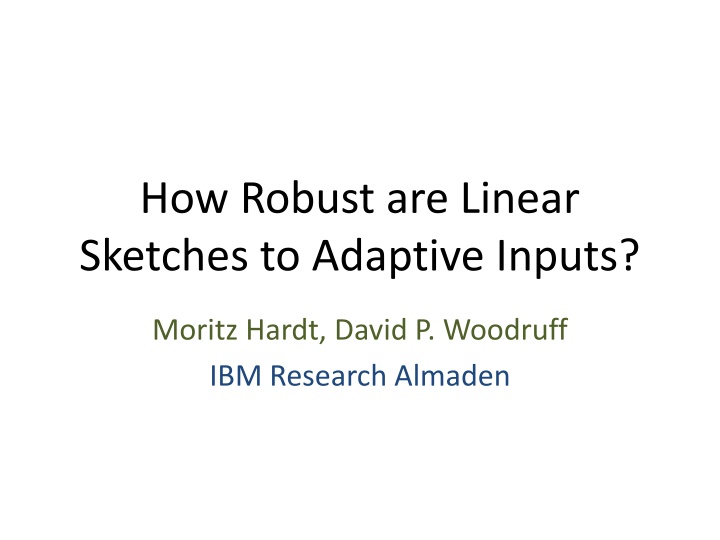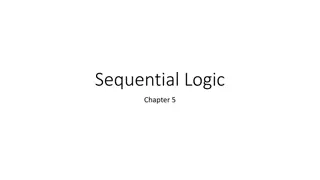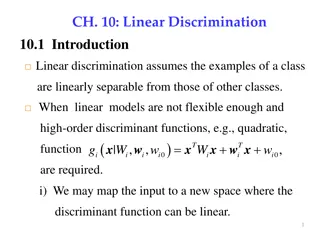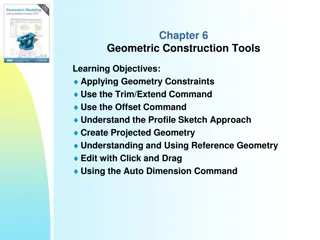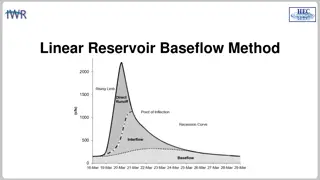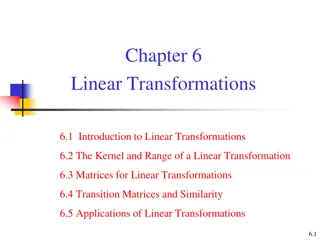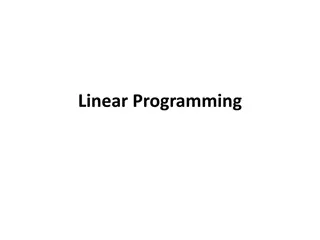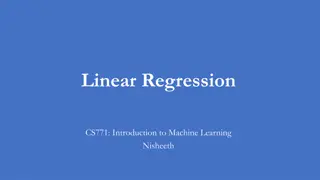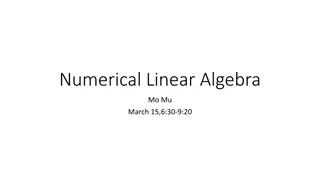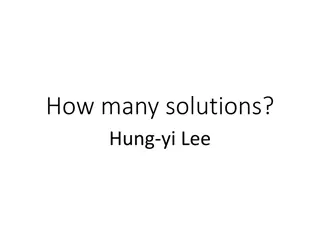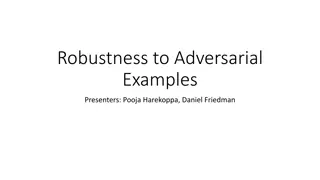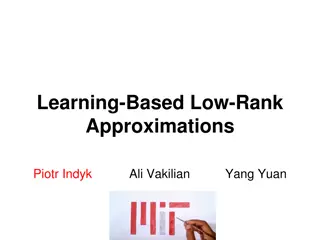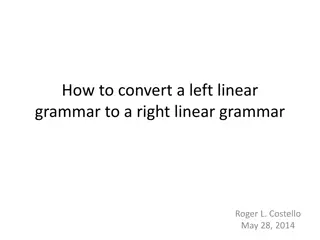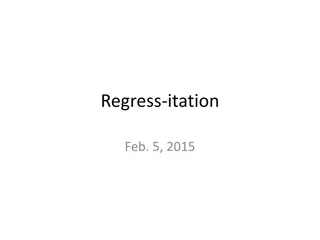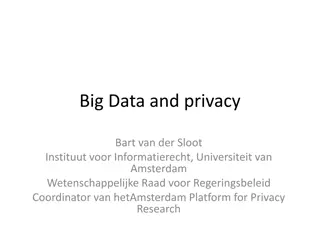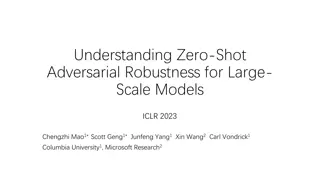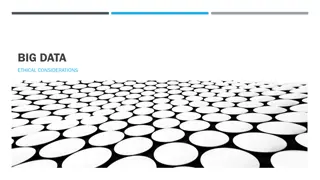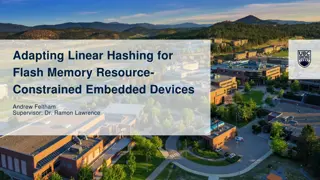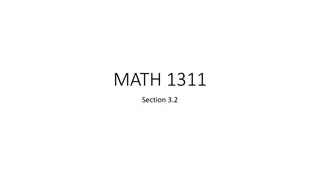Robustness of Linear Sketches to Adaptive Inputs in Big Data Processing
Exploring the robustness of linear sketches in handling adaptive inputs in big data scenarios. The study covers applications like compressed sensing, data streams, and distributed computation. It delves into the challenges posed by adaptive inputs and the implications for correctness and efficiency in algorithmic paradigms.
Download Presentation

Please find below an Image/Link to download the presentation.
The content on the website is provided AS IS for your information and personal use only. It may not be sold, licensed, or shared on other websites without obtaining consent from the author.If you encounter any issues during the download, it is possible that the publisher has removed the file from their server.
You are allowed to download the files provided on this website for personal or commercial use, subject to the condition that they are used lawfully. All files are the property of their respective owners.
The content on the website is provided AS IS for your information and personal use only. It may not be sold, licensed, or shared on other websites without obtaining consent from the author.
E N D
Presentation Transcript
How Robust are Linear Sketches to Adaptive Inputs? Moritz Hardt, David P. Woodruff IBM Research Almaden
Two Aspects of Coping with Big Data Efficiency Handle enormous inputs Robustness Handle adverse conditions Big Question: Can we have both?
Algorithmic paradigm: Linear Sketches Applications: Compressed sensing, data streams, distributed computation, ... Unifying idea: Small number of linear measurements applied to data Data vector x in Rn Output Sketch y = Ax in Rr Linear map A For this talk: output can be any (not necessarily efficient) function of y r << n
For each correctness For each x: Pr { Alg(x) correct } > 1 1/poly(n) Pr over randomly chosen matrix A Does this imply correctness on many inputs? Only under modeling assumption: Inputs are non-adaptively chosen No guarantee if input x2 depends on Alg(x1) for earlier input x1 Why not?
Example: Johnson-Lindenstrauss Sketch Goal: estimate |x|2 from |Ax|2 JL Sketch: if A is a k x n matrix of i.i.d. N(0, 1/k) random variable with k > log n, then Pr[|Ax|2 = (1 1/2)|x|2] > 1-1/poly(n) Attack: 1. Query x = ei and x = ei + ej for all standard unit vectors ei and ej Learn |Ai|2, |Aj|2, |Ai + Aj|2, so learn <Ai, Aj> 2. Hence, learn AT A, and learn kernel of A 3. Query a vector x 2 kernel(A)
Correlations arise in nearly any realistic setting Adversarial Benign/Natural Monitor traffic using sketch, re-route traffic based on output, affects future inputs. DoS attack on network monitoring unit Can we thwart the attack? Can we prove correctness? In this work: Broad impossibility results
Benchmark Problem GapNorm(B): Given decide if (YES) (NO) Goal: Show impossibility for very basic problem. Easily solvable for B = 1+ using for each guarantee by sketch with O(log n/ 2) rows using JL.
Main Result Theorem. For every B, given oracle access to a linear sketch using dimension r n log(Bn), we can find in time poly(r,B) a distribution over inputs on which sketch fails to solve GapNorm(B) Efficient attack (rules out crypto), even slightly non-trivial sketching dimension impossible Corollary. Same result for any lp-norm. Corollary. Same result even if algorithm uses internal randomness on each query.
Application to Compressed Sensing l2/l2 recovery: on input x, output x for which: Theorem. No linear sketch with o(n/C2) rows gurantees l2/l2 sparse recovery with approximation factor C on a polynomial number of adaptively chosen inputs. Note: Impossible to achieve with deterministic matrix A, but possible with for each guarantee with r = k log(n/k). [Gilbert-Hemenway-Strauss-W-Wootters12] has some positive results
Outline Proof of Main Theorem for GapNorm Proved using Reconstruction Attack Sparse Recovery Result By Reduction from GapNorm Not in this talk
Computational Model 1. Sketches Ax and UTx are equivalent, where UT has orthonormal rows and row-span(UT) = row-span(A) Definition (Sketch) An r-dimensional sketch is any function 2. Sketch UTx equivalent to PU x = UUT x satisfying for some subspace Why? Sketch has unbounded computational power on top of PUx
Algorithm (Reconstruction Attack) Input: Oracle access to sketch f using unknown subspace U of dimension r Put V0 = {0}, subspace of 0 dimension Fort = 1 tot = r: (Correlation Finding) Find vectors x1,...,xm weakly correlated with unknown subspace U, orthogonal to Vt-1 (Boosting) Find single vector x strongly correlated with U, orthogonal to Vt-1 (Progress) Put Vt = span{Vt-1, x} Output: Subspace Vr
Algorithm (Reconstruction Attack) Input: Oracle access to sketch f using unknown subspace U of dimension r Put V0 = {0}, empty subspace Fort = 1 tot = r: (Correlation Finding) Find vectors x1,...,xm weakly correlated with unknown subspace U, orthogonal to Vt-1 (Boosting) Find single vector x strongly correlated with U, orthogonal to Vt-1 (Progress) Put Vt = Vt-1 + span{x} Output: Subspace Vr
Conditional Expectation Lemma Lemma. Given d-dimensional sketch f, we can find using poly(d) queries a distribution g such that: Moreover, 1. poly(1/d) 2. g = N(0, )n for a carefully chosen unknown to sketching algorithm Advantage over random
Simplification Fact: If g is Gaussian, then PUg = UUTg is Gaussian as well Hence, can think of query distribution as choosing random Gaussian g to be inside subspace U. We drop the PU projection operator for notational simplicity.
The three step intuition (Symmetry) Since the queries are random Gaussian inputs g with an unknown variance, by spherical symmetry, sketch f learns nothing more about query distribution than norm |g| (Averaging) If |g| is larger than expected, the sketch is more likely to output 1 (Bayes) Hence, by sort-of-Bayes-Rule, conditioned on f(g)=1, expectation of |g| is likely to be larger
Def. Let p(y) = Pr{ f(y) = 1 } y in U uniformly random with |y|2 = s Fact. If g is Gaussian with E|g|2 = t, then, density of 2-distribution with expectation t and d degrees of freedom
By correctness of sketch p(s) = Pr(f(y) = 1) y in U unif. random with |y|2 = s 1 ? 0 Norm s d/n l Bd/n r
Sliding 2-distributions (s) = sl r (s-t) vt(s) dt (s) < 0 unless s > r O(r1/2 log r) s01 (s) ds =s01sl r (s-t) vt(s) dt ds = 0
Averaging Argument h(s) = E[f(gt) | |g|2 = s] Correctness: For small s, h(s) 0, while for large s, h(s) 1 s01 h(s) (s) ds =s01sl r h(s) (s-t) vt(s) dt ds d 9 t so that s01 h(s) s vt(s) ds t s01 vt(s) ds + d/(l-r) For this t, E[|gt|2 | f(gt) = 1] t +
Algorithm (Reconstruction Attack) Input: Oracle access to sketch f using unknown subspace U of dimension r Put V0 = {0}, empty subspace Fort = 1 tot = r: (Correlation Finding) Find vectors x1,...,xm weakly correlated with unknown subspace U, orthogonal to Vt-1 (Boosting) Find single vector x strongly correlated with U, orthogonal to Vt-1 (Progress) Put Vt = Vt-1 + span{x} Output: Subspace Vr
Boosting small correlations n 1. Sample poly(r) vectors using CoEx Lemma x1 x2 x3 . . . M = 2. Compute top singular vector x of M poly(r) Lemma: |PUx| > 1-poly(1/r) Proof: Discretization + Concentration xm
Implementation in poly(r) time W.l.og. can assume n = r + O(log nB) Restrict host space to first r + O(log nB) coordinates Matrix M is now O(r) x poly(r) Singular vector computation poly(r) time
Iterating previous steps Generalize Gaussian to subspace Gaussian = Gaussian vanishing on maintained subspace Vt Intuition: Each step reduces sketch dimension by one. After r steps: 1. Sketch has no dimensions left! 2. Host space still has n r > O(log nB) dimensions
Problem Top singular vector not exactly contained in U Formally, sketch still has dimension r Can fix this by adding small amount of Gaussian noise to all coordinates
Algorithm (Reconstruction Attack) Input: Oracle access to sketch f using unknown subspace U of dimension r Put V0 = {0}, empty subspace Fort = 1 tot = r: (Correlation Finding) Find vectors x1,...,xm weakly correlated with unknown subspace U, orthogonal to Vt-1 (Boosting) Find single vector x strongly correlated with U, orthogonal to Vt-1 (Progress) Put Vt = Vt-1 + span{x} Output: Subspace Vr
Open Problems Achievable polynomial dependence still open Optimizing efficiency alone may lead to non- robust algorithms - What is the trade-off between robustness and efficiency in various settings of data analysis?
